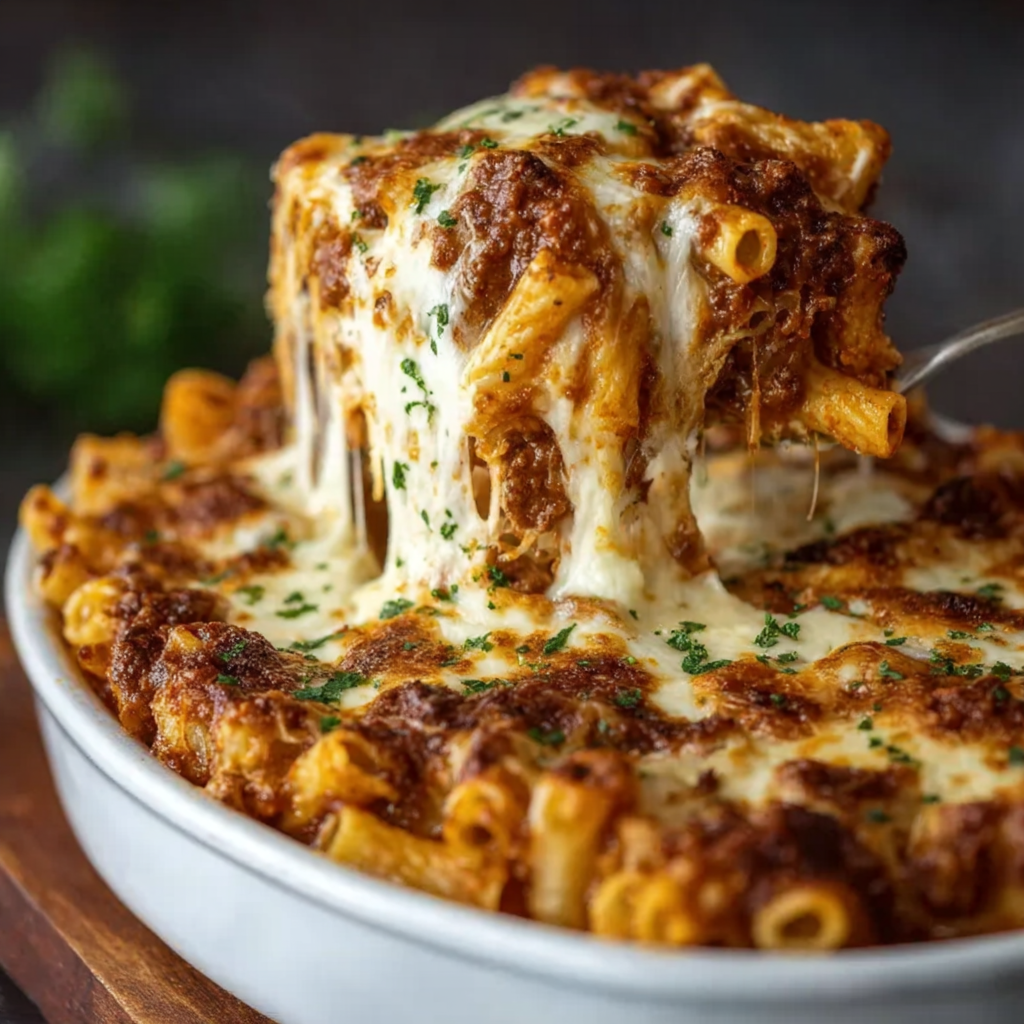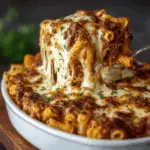Few dishes rival the warm embrace of baked ziti when seeking ultimate comfort food. A golden layer of melted mozzarella crowns perfectly al dente pasta, while creamy ricotta mingles with robust marinara sauce to create a symphony of flavors.
In this guide, you’ll learn:
- How to select and prepare the finest ricotta cheese for an extra-luscious filling, as detailed in the Ricotta cheese entry.
- Expert layering strategies found under Key Ingredients to achieve even sauce distribution.
- Pro tips for achieving the ideal bake every time.
- Discover delicious variations, including meat-free and sausage-infused versions.
Trace the heritage of ziti pasta from traditional Italian roots to modern tables by exploring Ziti pasta and dive deeper in the Origins & Evolution section. Embark on this culinary journey to master the secrets behind a show-stopping baked ziti. This first section lays the foundation for an unforgettable bake, aroma, and flavor.
The Origins & Evolution of Baked Ziti
The roots of baked ziti trace back to traditional pasta al forno dishes in southern Italy, where home cooks layered tubular pasta with cheese and sauce before roasting in brick ovens. Early recipes often used simple ingredients like ricotta and fresh tomato purée, reflecting a cuisine grounded in frugality and flavor.
As Italian immigrants settled in North America, the dish evolved into a staple of Italian-American cuisine, adapting to local ingredients and tastes. The substitution of local produce and the use of dried, store-bought sauces paved the way for widespread popularity. Explore how ziti pasta became the vessel of choice and learn layering techniques in the Key Ingredients section.
The rise of canned goods and pre-made sauces during the mid-20th century further transformed the recipe, giving birth to the robust marinara sauce that defines modern bakes. Discover the evolution of flavors by checking Marinara sauce and exploring the Step-by-Step Preparation chapter.
Key influences include:
- Brick-oven traditions
- Regional cheese varieties
- Adaptation to American kitchens
- Expansion through family gatherings and community potlucks, fostering recipe sharing
- Modern variations include sausage, spinach, and gluten-free options
- Tradition continues
The Origins & Evolution of Baked Ziti
The roots of baked ziti trace to traditional pasta al forno in southern Italy, where families layered tubular pasta with fresh ricotta and tomato purée before roasting in brick ovens. Early iterations highlighted local ingredients like mozzarella and regional herbs, reflecting a resourceful cuisine built on simplicity and taste.
As Italian immigrants arrived in North America, baked ziti evolved into a hallmark of Italian-American cuisine, adapting to available produce and pantry staples. Canned tomatoes and dried pasta made the dish accessible year-round. Discover how ziti pasta became the perfect sauce carrier and explore ingredient insights in the Key Ingredients section.
The mid-20th century saw the advent of jarred sauces, ushering in the classic marinara sauce flavor profile we know today. Rich garlic, oregano, and basil notes combined with sweetness from plum tomatoes, as detailed in the Marinara sauce entry, create a balanced base for creamy cheese layers. Later innovations introduced meats, vegetables, and gluten-free alternatives, ensuring baked ziti remains a versatile comfort dish.
Key influences include:
- Brick-oven cooking traditions
- Regional cheese selections
- Family-style sharing culture
- Adaptation to modern kitchens
- Creative variations (sausage, spinach, gluten-free)
This rich history continues to inspire home cooks worldwide, blending tradition with creative flair for consistently memorable seasonal dishes.
Key Ingredients for Perfect Baked Ziti
Ricotta Cheese
Selecting high-quality ricotta cheese is crucial for a silky filling that elevates baked ziti. Opt for whole-milk varieties over part-skim to maximize fat content, which yields a richer texture and flavor. Before blending, drain excess whey through a fine mesh to prevent watery layering. In recipes inspired by Italian staples, such as those in the Ricotta cheese entry, careful moisture control ensures consistent bake. Mixing an egg into the ricotta adds structure and prevents separation during roasting. For visual inspiration and community-tested variations, refer to the ricotta cheese recipes board, which showcases diverse approaches from creamy fillings to tangy herbed blends. Remember that the balance of creaminess and firmness directly impacts sauce adherence, so measure precisely. Consult the Origins & Evolution section for historical context and pairing recommendations. Experimenting with homemade ricotta mixtures can further customize flavor profiles and enrich textural contrast in every bite for memorable dinners, truly unforgettable.
Marinara Sauce
Crafting the ideal marinara sauce is essential for a balanced baked layer that complements creamy cheese. Begin by sautéing minced garlic and shallots in olive oil until fragrant, then stir in crushed plum tomatoes for a natural sweetness. Simmer gently to concentrate flavors and reduce excess liquid, ensuring a thick consistency that adheres to pasta tubes. For a classic reference, see Marinara sauce and discover homemade techniques on the Homemade marinara sauce board. Enhance complexity by adding dried oregano, fresh basil leaves, and a pinch of red pepper flakes, balancing acidity and sweetness perfectly. To visualize optimal texture before baking, explore various community-created photos from the Baked pasta recipe ideas collection. This sauce foundation feeds into the step-by-step layering process described in the Step-by-Step Preparation section, guiding you to assemble with precision. The resulting marinara melds seamlessly with ricotta, creating depth in every savory mouthful, truly capturing authentic Italian essence.
Ziti Pasta
Choosing the right ziti pasta tube is vital for optimal sauce retention and texture. Unlike flat pastas, its hollow shape captures marinara and cheese in every bite. Cook tubes to al dente, undercooking by one minute to ensure firmness during baking. Explore the Ziti pasta entry for shape characteristics, and learn about regional adaptations in the Italian cuisine overview. Proper draining prevents excess moisture, while tossing with a bit of oil stops sticking. Reference the Step-by-Step Preparation guide for precise timing and layering instructions. For visual examples of cooking techniques, check curated photos on the popular Italian pasta dishes board.
Cheese Blend (Mozzarella & Parmesan)
Combining stretchy mozzarella with sharp Parmesan creates a perfect balance between melt and flavor intensity. Use whole milk mozzarella for optimal stretch, shredding it fresh from the block to prevent waxy coatings. Grate Parmesan yourself to capture robust umami, and reserve a small sprinkle for topping browning. For authentic inspiration, explore the Baked ziti entry and browse the Comfort food recipe board to visualize ideal cheese pulls. Layer cheeses evenly, integrating them between ricotta layers. For advanced layering hacks, refer to the Expert Tips & Secret Techniques section and elevate every bite with golden crust and vibrant color pops throughout.
Seasonings & Optional Proteins
Selecting the right seasonings elevates every bite. Core aromatics include minced garlic, dried oregano, and fresh basil. Balance flavors by sautéing garlic in olive oil before adding marinara.
For optional proteins, Italian sausage lends spiced richness, while lean ground turkey offers a lighter alternative. Brown meat thoroughly with seasonings to maximize depth. Vegetarians can boost umami with sautéed mushrooms or spinach leaves. Explore additional protein ideas in the Origins & Evolution section for context. Protein-rich plant-based alternatives, lentils or vegan sausage, let you adapt baked ziti to dietary preferences without sacrificing bold flavor. Adjust salt and pepper to taste.
Step-by-Step Preparation
Begin by preheating the oven to 375°F (190°C) and assembling all ingredients. Cook 1 lb ziti pasta in a large pot of generously salted boiling water until just al dente—about 1 minute less than package instructions. Drain and toss immediately with a tablespoon of olive oil to prevent sticking.
- Prepare the Sauce:
- In a heavy skillet over medium heat, warm 1 Tbsp olive oil.
- Sauté 2 minced cloves of garlic until fragrant, then add optional meat and brown.
- Pour in 3 cups marinara sauce, simmer 5 minutes to concentrate flavors.
- Mix the Cheese Filling:
- In a large bowl, combine 2 cups ricotta cheese, 1 large beaten egg, half of the shredded mozzarella, and half of the grated Parmesan.
- Stir until smooth, adding a pinch of salt and pepper.
- Layer the Dish:
- Spread a thin layer of sauce on the bottom of a 9×13-inch baking dish.
- Add the ricotta–pasta mixture, then cover with remaining sauce.
- Evenly sprinkle remaining mozzarella and Parmesan on top.
- Bake & Finish:
- Cover with foil and bake 25 minutes.
- Remove foil and bake an additional 10–15 minutes until cheese is melted and bubbly.
- Let rest 5–10 minutes before serving.
Continue to the Expert Tips & Secret Techniques section for advanced hacks that guarantee a perfect golden crust every
Expert Tips & Secret Techniques
Perfecting baked ziti means mastering a few insider tricks that ensure every bite is rich, creamy, and crisp. These advanced methods build on the foundations laid in the Key Ingredients for Perfect Baked Ziti and the Step-by-Step Preparation sections, refining texture and flavor at every stage.
Before you assemble, revisit how ingredient temperature and moisture levels affect layering. For customization ideas, check the Variations & Customizations guide, and when you’re ready to serve, see our Serving Suggestions & Pairings recommendations to complete the experience.
Achieving a Luscious Ricotta Mixture
- Drain thoroughly: Line a fine-mesh sieve with cheesecloth, and let whole-milk ricotta rest for 30 minutes to remove excess whey.
- Egg integration: Beat the egg first, then stir gently into ricotta to bind without overwhipping.
- Texture check: Aim for a spreadable consistency that clings to pasta—too thin and it slides off, too thick and it won’t meld with sauce.
- Flavor boost: Fold in a pinch of nutmeg and finely chopped parsley to enhance depth without overpowering the creamy base.
Optimizing Sauce Flavor
- Layered simmering: Cook garlic and shallots first, then add half the herbs; reserve the rest for a finish just before baking.
- Acidity balance: Stir in a teaspoon of sugar if plum tomatoes are too tart, tasting as you go.
- Fresh finishes: Tear basil leaves by hand and fold them in at the end to preserve bright aromatics.
Perfect Al Dente Texture
- Undercook by design: Boil ziti one to two minutes less than package instructions to avoid mush after baking.
- Oil toss: Immediately toss drained pasta with a tablespoon of olive oil to prevent sticking and ensure even sauce coating.
Baking & Browning Hacks
- Foil strategy: Cover loosely with foil for the first 75% of baking, then remove to expose cheese for golden spots.
- High-heat finale: Switch to broil for the last 1–2 minutes, watching closely to avoid burning while achieving an irresistible crust.
- Resting period: Let the casserole sit 10 minutes after baking; this helps the layers set, making slicing cleaner.
Variations & Customizations
To cater to diverse tastes, experiment with these adaptations:
- Vegetarian Version: Substitute meat with roasted eggplant and spinach, stirring wilted greens into the cheese layer.
- Meat-Lovers’ Ziti: Brown Italian sausage or meatballs with garlic before adding marinara for extra savory depth.
- Gluten-Free / Dairy-Free Options: Use gluten-free ziti and replace ricotta with cashew-based cheese; finish with dairy-free mozzarella shreds.
Serving Suggestions & Pairings
Elevate your meal with:
- Wine matches: A medium-bodied Chianti or Sangiovese brings bright acidity to cut through richness.
- Side dishes: Crisp Caesar salad or garlic-herb focaccia balances creaminess and adds textural contrast.
Storage, Reheating & Freezing
- Refrigerate: Store leftovers in an airtight container for up to 3 days.
- Reheat: Warm individual portions in a 350°F oven for 15 minutes, covered with foil to prevent drying.
- Freeze: Assemble unbaked, wrap tightly, and freeze up to one month; bake from frozen, adding an extra 15 minutes under foil.
FAQs
- Can I assemble ahead and bake later?
Yes. Assemble in the dish, cover, and refrigerate up to 24 hours before baking. - How do I prevent soggy pasta?
Undercook by 1–2 minutes and drain well; toss with olive oil immediately. - What’s the best way to reheat leftovers?
Cover with foil and bake at 350°F for 15–20 minutes, or microwave individual portions until heated through.
From Ricotta Cheese to Marinara Sauce: Secrets of the Perfect Baked Ziti
This Ultimate Baked Ziti With Ricotta is a soul-warming masterpiece, featuring al dente ziti enveloped in a creamy ricotta-egg blend and layered with a robust, herb-infused marinara sauce. A two-cheese crown of fresh mozzarella and grated Parmesan creates a golden, bubbly top that gives way to velvety depths. Perfect for family dinners, potlucks, or any night you crave cozy, satisfying fare.
Ingredients
- 1 lb ziti pasta
- 2 cups ricotta cheese
- 2 cups shredded mozzarella cheese, divided
- ½ cup grated Parmesan cheese
- 1 large egg
- 3 cups marinara sauce
- 1 tbsp olive oil
- 2 cloves garlic, minced
- 1 tsp dried oregano
- Salt and pepper to taste
- Optional: ½ lb ground beef or turkey for added protein
Instructions
Preheat your oven to 375°F (190°C).
Cook the ziti pasta in a large pot of salted boiling water until al dente. Drain and set aside.
In a large skillet, heat olive oil over medium heat. Add minced garlic and cook until fragrant. If using, add ground beef or turkey and cook until browned. Season with salt, pepper, and oregano. Stir in the marinara sauce and simmer for a few minutes.
In a large bowl, mix ricotta cheese, egg, half of the mozzarella, and half of the Parmesan. Stir until well combined.
Add the cooked pasta to the ricotta mixture and mix until the pasta is evenly coated.
In a 9×13 inch baking dish, spread a layer of the meat sauce (or just marinara if no meat used). Add the ricotta-pasta mixture on top. Spread the remaining sauce over the pasta. Sprinkle with the remaining mozzarella and Parmesan cheese.
Cover with foil and bake for 25 minutes. Remove foil and bake for another 10-15 minutes, or until cheese is melted and bubbly.
Let rest for 5-10 minutes before serving.
Notes
-
Advance prep: You can prepare components (ricotta mixture, sauce, cooked pasta) up to 24 hours prior. Assemble just before baking for maximum freshness.
-
Make it vegan: Swap dairy cheeses for cashew-based ricotta and vegan mozzarella; use plant-based sausage or mushrooms for texture.
-
Spice it up: Add red pepper flakes to the sauce or sprinkle cayenne into the ricotta mix for a mild kick.
-
Serving size: Recipe yields six generous portions. Adjust pasta and cheese quantities proportionally for larger batches.
-
Storage tips: For airtight storage, press plastic wrap directly onto the cheese surface to prevent a dry skin from forming.




